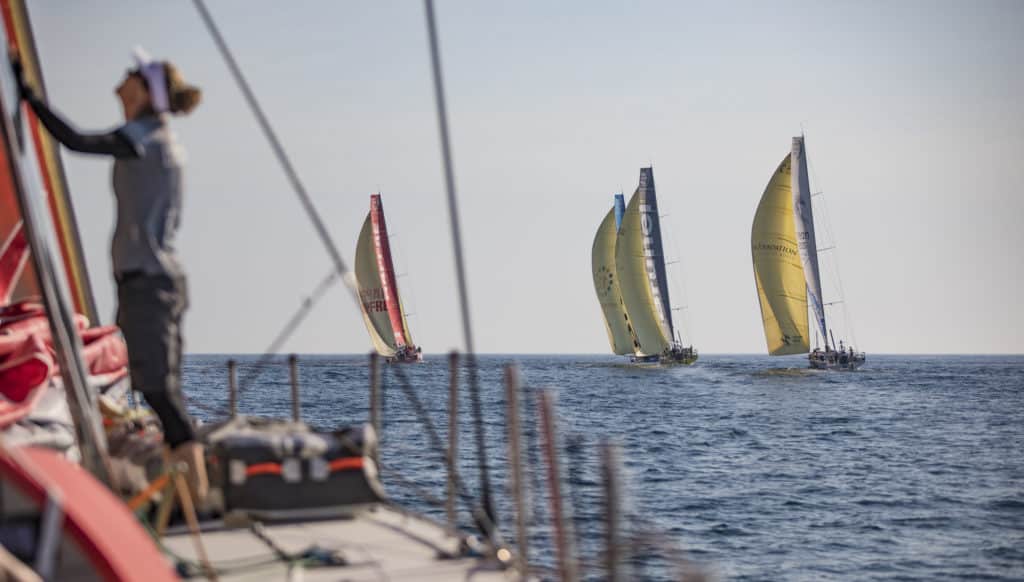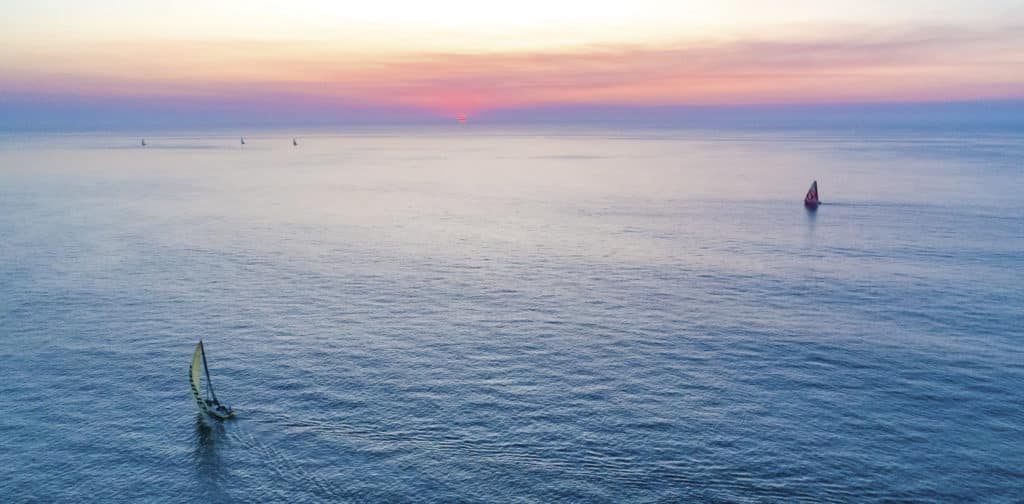
Leg Zero, Prologue start on-board Dongfeng. Dongfeng has a bad start and sails in the back of the fleet.Photo by Jeremie Lecaudey. 08 October, 2017
The Prologue is a non-scoring race to deliver the seven-boat fleet from The Boatyard in Lisbon, Portugal to the home start port of the Volvo Ocean Race in Alicante, Spain ahead of the race start on 22 October.
At the scheduled start time of 1400 local time in Lisbon on Sunday afternoon (1300 UTC), the sea was like glass with extremely light and variable winds.
Race Director Phil Lawrence and his team asked the crews to proceed due south, under power, towards Gibraltar, and two-hours later the fleet was rewarded with a light, but steady 7 to 10 knot northwesterly breeze, allowing racing to start at 1515 UTC.
Xabi Fernández and his MAPFRE team led the fleet off the starting line, racing downwind in a drag race to get south.
“This prologue is a great opportunity as a warm-up because then we go straight into the coastal race and the first leg. We are really looking forward to it, and are all very motivated,” said Pablo Arrarte, watch captain on MAPFRE, as the team left the dock.
In contrast, Dongfeng Race Team was shut out from the starting line at the committee boat end and trailed the fleet across the line.
Thirty minutes after the start, there was an east / west split emerging, with Team Brunel furthest east and slightly behind the leaders, with Vestas 11th Hour Racing furthest west and nominally in the lead.
“It feels different when it’s game day,” said Charlie Enright, skipper of Vestas 11th Hour Racing. “For this Prologue, it’s all about learning. We’re interested to see where we stand against these guys. We’ve done some two boat testing and it’ll be interesting to see how fast we’ve gotten because the fastest boat is going to win this race.”
The original leg from Lisbon to Alicante was 700 nautical miles. The new start position shortens the leg to approximately 680 nautical miles.
According to our @RaceExperts, the forecast is for light conditions to Gibraltar, where the teams will encounter moderate to strong easterlies in the Strait, followed by lighter conditions again once the fleet transitions into the Mediterranean Sea.
The Volvo Ocean Race will start from Alicante, Spain on 22 October. The Alicante Race Village is scheduled to open at 1800 local time on Wednesday afternoon, with the In-Port Race on Saturday 14 October.

Leg Zero, Prologue start. Drone shots a couple of hours after the Start on-board Dongfeng. Dongfeng had a bad start and sails in the back of the fleet. Photo by Jeremie Lecaudey. 08 October, 2017
The Latest News
The images of Volvo Ocean Race boats in near calm conditions during the first 24-hours of the Prologue leg from Lisbon to Alicante may give the impression of a relaxing cruise down the coast to the gates of the Mediterranean.
The reality is the contrary. Light, variable conditions are a nightmare for the sailors, who end up agonising over every tack or gybe in search of each little zephyr. Sails are adjusted, course corrections are a constant, and eyes strain at the horizon looking for any sign of a change.
During the first 24 hours of the Prologue, a critical decision faced the teams.
“There was a big choice to make at the end of the night,” explained Jérémie Beyou on Dongfeng Racing Team. “Do you stay offshore like we did, or do you try to escape the light air by the coast?”
The early returns are decidedly in favour of the coastal route, with MAPFRE and Team Brunel marching out to a 40-plus mile lead over the rest of the fleet who stayed 30 miles further west.
But the entire fleet now needs to navigate past another big light patch, before finding stronger conditions near Gibraltar.
“It’s going to be a long one,” said a frustrated Liz Wardley from Turn the Tide on Plastic, noting it would normally take about three days to complete the leg.
Her boat was trailing the fleet on the Monday afternoon position report, but making twice the speed of the four boats immediately in front, so there is still plenty of opportunities as we head into the second night at sea.









